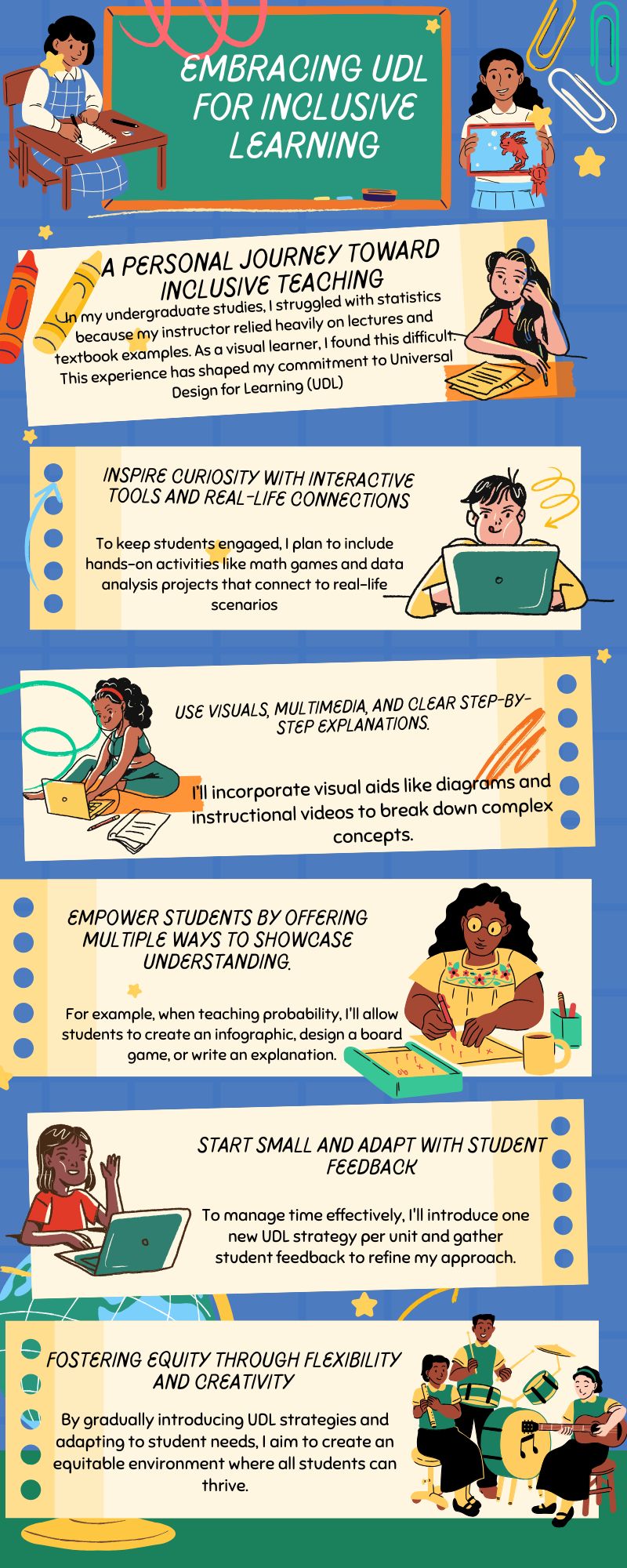Author:
During my undergraduate studies in India, I struggled with a statistics course because my teacher relied heavily on lectures and textbook examples without visual aids or interactive elements. As I learn better with visual representations, I found it difficult to grasp concepts like probability distributions and data analysis. Reflecting on this experience, I realize that incorporating Universal Design for Learning (UDL) principles could have made a significant difference in my learning journey. According to Meyer, Rose, and Gordon (2014), UDL encourages multiple means of engagement, representation, and expression to support diverse learning needs. For example, providing visual diagrams, interactive simulations, or even real-life data scenarios would have enhanced my understanding.
In my future classroom, I plan to apply UDL by integrating multiple means of representation. For example, when teaching math concepts, I will combine verbal explanations with visual aids like charts, diagrams, and manipulatives (Meyer et al., 2014). Additionally, I will encourage students to express their understanding through various formats, such as presentations, written responses, or creative projects, which will ensure equal opportunities for diverse learners to have equitable access to learning.
To ensure my classroom is inclusive for all students, I will create a flexible learning environment that accommodates different learning styles and abilities. As Meyer et al. (2014) emphasize, designing a flexible classroom environment can foster student engagement by offering choices in learning materials, seating arrangements, and participation formats such as group tables, individual desks, or quiet zones for students who need minimal distractions. I will also provide multiple pathways for students to engage with the content, including hands-on activities, peer discussions, and digital resources. For example, when teaching a science unit, I might use models and experiments for kinesthetic learners while incorporating videos and visual aids for visual learners.
One of the challenges I might face is balancing multiple strategies while managing time effectively. To address this, I will start by gradually incorporating UDL strategies and using digital tools like Google Slides or interactive apps that efficiently support various learning needs. I will seek feedback from students to understand what strategies are most effective for them to let my teaching methods continue to evolve and improve.
Note
To model UDL principles, I have incorporated an infographic multimedia component to present my ideas. This approach aligns with Universal Design for Learning by providing multiple methods of engagement, representation, and expression. The infographic highlights strategies such as interactive activities, real-world data connections, and hands-on projects to capture student interest. Visual aids like diagrams and instructional videos are emphasized as tools for presenting information clearly and effectively. The infographic illustrates flexible options for students to demonstrate their learning, including podcasts, posters, and creative projects.
Please click on the link for an infographic https://www.canva.com/design/DAGiBcpAnoE/JUwVSAbkwitq5y7UzUa8Pg/edit
References
Meyer, A., Rose, D. H., & Gordon, D. (2014). Universal design for learning: Theory and practice. CAST Professional Publishing. https://publishing.cast.org/catalog/books-products/universal-design-for-learning-meyer-rose-gordon

Hi Vandana,
The first part of your write up demonstrates the important connection between personal experience and pedagogical approach. Explaining your struggle with statistics due to a lack of visual learning options directly explains your commitment to Universal Design for Learning principles, showing how our challenges can shape our teaching philosophy. The specific plans to implement UDL are practical and comprehensive. I particularly value your emphasis on multiple means of representation for math concepts and flexible assessment options, which address the core UDL framework effectively. Moreover, your emphasis on the physical classroom environment like different seating arrangements and library corners implies a real sense that inclusive education is not merely about the curriculum. Overall, encouraging feedback from the students further fosters a cycle of continuous improvement.
Hi, Vandana,
Thanks for your sharing. I am very impressive to your concept and argument. I truly appreciate your thoughtful perspective on inclusive education in India. Your emphasis on both the advancements and the existing hurdles is commendable. Highlighting Universal Design for Learning (UDL) as a promising approach is particularly noteworthy. In addition, according to adopting varied teaching strategies like videos, collaborative discussions, and interactive activities, teachers can more effectively meet the diverse needs of their students. By the way, creating an atmosphere where teachers feel empowered to try new inclusive techniques is vital. Finally, you mentioned you paid attention on students’ feedbacks, which i cannot agree more. Students’ feedbacks are just like teachers’ self-reflection. Both of these can be very helpful to enhance our teaching outcome and performance.
Your inclusion of the infographic is very creative, and it demonstrates UDL principles. Well done.